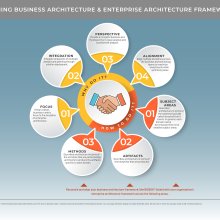StraightTalk focuses on business architecture, but we know that our discipline is part of a larger entity — the enterprise architecture (EA) umbrella (see Posts No. 14 and No. 15). As a result, a strong partnership among every one of the architecture disciplines is critical for all of our success — and for the success of our organizations.
We are proud supporters and contributors to the Business Architecture Guild® and the BIZBOK® Guide, which is the business architecture body of knowledge. However, when we practice business architecture in our organizations, we need to make sure that we integrate with our all of our EA partners and any EA frameworks they use. This installment of StraightTalk focuses on one of those EA frameworks: TOGAF®.
We were fortunate to speak with two highly accomplished and respected business architecture practitioners, Bryan Lail and Steve DuPont. Bryan and Steve are part of a team of Certified Business Architects® from the Business Architecture Guild®, working on the Business Architecture Workstream, within the Open Group Architecture Forum, to align the TOGAF® enterprise architecture framework with the BIZBOK® Guide. While there is still much work to come, we think the notable progress that has been made so far is important to highlight now.
In our recently recorded podcast, Bryan and Steve broke down the key things we need to know about the TOGAF®–BIZBOK® Guide alignment. Disclaimer: we’ve made some adjustments for our typical StraightTalk-style: the headings represent StraightTalk asking the questions and our guests, Bryan and Steve, respond in turn.
Make sure to check out the interview with Bryan and Steve firsthand in our StraightTalk podcast 10-Minutes With Bryan Lail and Steve DuPont.
First, can one of you help us understand what TOGAF® is and why this is important for business architects to understand?
Bryan: “First, I’ll step back and call out the role of The Open Group in general. The Open Group is a global consortium that enables business objectives through the advancement of technology standards, and is an open consortium-based collaboration of member companies and many volunteers.
Within The Open Group, there are a number of forums and one of those forums is the Architecture Forum. The Architecture Forum within The Open Group manages the TOGAF® standard and associated ecosystem of guides and resources. The TOGAF® standard, currently at Version 9.2, is a proven enterprise architecture methodology and framework used by many organizations across the world. It provides a structure for their enterprise architecture framework, a methodology, and a development flow in a number of guides that are part of the ecosystem, which you will hear more about shortly.”
Some important updates have recently been made to update the business architecture perspective within TOGAF®. Can you walk us through why those changes were needed and how they are being made?
Bryan: “What has happened is the discipline of enterprise architecture, in general, has been around for a fair number of decades. Those of you who have been watching the StraightTalk series and involved in other ways with the Business Architecture Guild® or other disciplines, know that business architecture has made a lot of advancements in the last eight years or so—and a lot of those advancements were not in the TOGAF® framework. It was a standard used in many places for enterprise architecture and was frankly a bit weak on the business architecture side, including the guidance and methods for how one understands the business needs before developing solutions driven by an enterprise architecture framework.
So there was a knowledge need from the version of TOGAF® that had been around for about six or seven years, back from Version 9.1 in about 2011, in that the business architecture content was badly in need of an update. The Business Architecture Workstream in the Architecture Forum is essentially a team of people who are Certified Business Architects® by the Business Architecture Guild® and are also employees of member companies of The Open Group. We worked together on this workstream to integrate the business architecture practices and advancements into the TOGAF® enterprise architecture framework.”
What are the key updates that have been made so far?
Steve: “The key updates to the TOGAF® framework are focused on introducing three concepts important to business architecture: business models, business capabilities and value streams.
In TOGAF® Version 9.2, we establish the business model as a summary-level description of the rationale for how an enterprise creates, delivers, and captures value. We provide the structure and the guidance to enable a strategist or a business architect to create a business model. The business model is introduced in the TOGAF® Architecture Vision phase where it is evaluated, along with strategy, to identify the required business capabilities the enterprise must possess in order to act on strategic priorities.
This leads us to business capabilities which are the abilities that a business must have to achieve their purpose. We provide the structure and guidance for capability mapping to enable the business architect to identify, categorize and decompose the business capabilities the business requires.
We also establish the value stream as the main concept for representing the value-added activities that create an overall result for a customer, stakeholder or end user. We provide structure and guidance for value streams which help to keep the architecture effort aligned with business value.
Finally, I’d like to add that value streams and business capabilities are added to the TOGAF® Core Content Metamodel along with a new entity, Course of Action, which represents the direction and focus provided by strategic goals and objectives.”
When were those approved updates published and where can we access them?
Steve: “The TOGAF® standard which contains the core parts of the TOGAF framework was published in April of 2018. The detail guidance is contained in three separate TOGAF® Series Guides: The Value Streams Series Guide (published in 2017) and in 2018 we published the Business Model and the Business Capabilities Series Guides.”
So what is the current focus of the workstream and what sort of other updates can we expect in the future?
Bryan: “We have a lot going on in the workstream. We continue to move forward on two fronts, including both the TOGAF® standard and the associated series of guides. You will see when the next version of TOGAF® is released, which is now intended to be a yearly cycle, that there were a number of additional improvements made in the business architecture guidance. That included resolving some disparities on what business architecture means by products and services and business functions—as compared to what other levels of the architecture might expect—as well as introducing the concept of information mapping at a business architecture level. Associated with that, we just finished the draft of an information mapping guide, to add to the set of guides available. It is currently in company review. This guide will probably be released relatively soon.
In addition to the evolution of the framework itself, and the emergence of new guides, building on the Business Architecture Guild® principles pulled into this enterprise architecture framework, there have been many collaboration opportunities popping up.
Now that we are making advances and people are seeing it being integrated into the TOGAF® ecosystem, we have been getting a lot of requests for our workstream to work with other communities on Lean-Agile, on some other business practices and bringing them together, on a credential and how it relates back to the Business Architecture Guild® certification, and a number of other activities.
Here are some of the Whys and Hows for integrating business architecture into enterprise architecture frameworks:
Any closing comments?
Bryan: “Thank you for the opportunity and keep an eye out on events that are coming up in collaboration between The Open Group and the Business Architecture Guild®.”
Steve: “I’d like to add that it’s been a wonderful experience collaborating with some of the finest enterprise and business architects in the industry today. I want to thank the folks at the Open Group Architecture Forum and my business architecture teammates like Bryan, Stephen Marshall and Chalon Mullins for their contributions.”
More Good Stuff…
10-Minutes With Bryan Lail and Steve DuPont (StraightTalk podcast): Just in case you missed the link earlier in this post, make sure to check out the excellent podcast by Bryan and Steve — the basis for this post.
Part 6 of the BIZBOK® Guide (Business Architecture Guild®): If you haven’t read this section yet, there is a lot of great information here. Section 6.2 of the BIZBOK® Guide, in particular, discusses Business Architecture and Enterprise Architecture Framework Alignment and provides specific guidance on how to align the BIZBOK® Guide methods with EA frameworks such as TOGAF®, the Zachman FrameworkTM and others. (Business Architecture Guild® membership required.)
TOGAF® Series Guide: Business Capabilities (The Open Group): Here is the business capabilities guide referred to earlier. (Registration will be required at the link.)
TOGAF® Series Guide: Value Streams (The Open Group): Here is the value stream guide referred to earlier. (Registration will be required at the link.)
TOGAF® Series Guide: Business Models (The Open Group): Here is the business models guide referred to earlier. (Registration will be required at the link.)
Advancement of Business Architecture in the TOGAF® Ecosystem Webinar (Business Architecture Guild®): A must-listen-to webinar, presented by Bryan Lail and Steve DuPont, with more expansive content on this topic. (Business Architecture Guild® membership required.)
Advancement of Business Architecture in the TOGAF® Ecosystem Presentation (Business Architecture Guild®): A talk presented by Steve DuPont on this topic at the Business Architecture Guild® Business Architecture Innovation Summit in Ottawa, Canada in 2018. This presentation is a must-download as it provides great content on this topic, available in the public realm. (See Business Architecture Guild®Public Resources page.)
The TOGAF® Standard – Version 9.2 (The Open Group): The official TOGAF® Standard, reflecting the changes discussed earlier. This version of TOGAF®, made available in April 2018, includes critical artifacts and methods for the modern business architecture practice, supported by a series of guides (listed above) that delve deeper into methods and artifacts. (The Open Group membership required.)
How to Turn a Group of Strangers Into a Team (TED Talk): Good perspective from Amy Edmonson in her TED Talk about coming together as a team. To get there, we need to overcome “the basic human challenge: it’s hard to learn if you already know.”

